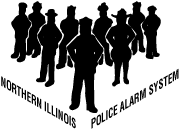
Northern Illinois Police Alarm System

The Northern Illinois Police Alarm System (NIPAS) represents a joint venture of suburban municipal police departments in the Chicago metropolitan area. Fifteen police agencies created NIPAS in 1983 to ensure effective police mutual aid in times of natural disasters. From these humble beginnings, the system has grown to include law enforcement agencies of over 100 cities, villages, and towns in five counties.
A governing board consisting entirely of police chiefs directs NIPAS and approves its annual budget, which serves as the basis for all NIPAS expenditures. Member agencies pay a set annual fee to participate, thus providing both the staff and the finances needed to manage the system.
Background
In 1982, severe flooding nearly devastated several small communities along the shores of Lake Michigan north of Chicago. Public safety resources, especially those of law enforcement agencies, became stretched to the limit. Although neighboring communities responded with assistance, police leaders realized they needed a better organized system with pre-planned deployment procedures. The following year, chiefs of fifteen police agencies in Illinois’ northern Cook and southern Lake counties established NIPAS through an intergovernmental mutual aid agreement. This legal document authorized neighboring agencies to work together in times of need. In 1988, bylaws formalized the original agreement.
Activating the System
Whether faced with a natural disaster of the unexpected results of a special event, a member agency may request assistance for any situation its command staff believes the agency cannot handle with its own resources. The requesting agency’s incident commander contacts the system’s dispatching center, Northwest Central Dispatch System, and identifies the level of response needed. There are ten levels, each one calling for an additional five officers to respond according to a pre-determined alarm plan. Thus, Level 1 requires five officers to respond; Level 10 requires fifty.
The dispatch center quickly sends the appropriate number of fully equipped officers to a pre-selected mobilization point within the requesting agency’s jurisdiction. The incident commander also deploys a personnel officer, who records each officer’s arrival and assigns each one as required.
Additional Resources
NIPAS member agencies have the option of participating in two additional NIPAS programs… a special tactical squad know as the Emergency Services Team and a special crowd control team known as the Mobile Field Force.
NIPAS Agencies
- Addison
- Antioch
- Arlington Heights
- Bannockburn
- Barrington
- Barrington Hills
- Bartlett
- Bellwood
- Bensenville
- Berwyn
- Bloomingdale
- Broadview
- Buffalo Grove
- Burr Ridge
- Carol Stream
- Carpentersville
- Cary
- College of Lake County
- Crystal Lake
- Deerfield
- Des Plaines
- Downers Grove
- Elk Grove Village
- Elmhurst
- Elmwood Park
- Evanston
- Forest Park
- Fox Lake
- Franklin Park
- Glencoe
- Glenview
- Golf
- Grayslake
- Gurnee
- Hanover Park
- Harper College
- Harwood Heights
- Highland Park
- Highwood
- Hoffman Estates
- Indian Head Park
- Inverness
- Itasca
- Kenilworth
- Kildeer
- La Grange
- La Grange Park
- Lake Bluff
- Lake Forest
- Lake Villa
- Lake Zurich
- Libertyville
- Lincolnshire
- Lincolnwood
- Lyons
- Maywood
- McCook
- McHenry
- Melrose Park
- Morton Grove
- Mount Prospect
- Mundelein
- Niles
- Norridge
- North Riverside
- Northbrook
- Northfield
- Northlake
- Oak Brook
- Oakbrook Terrace
- Palatine
- Park Ridge
- Prospect Heights
- River Forest
- River Grove
- Riverside
- Riverwoods
- Rolling Meadows
- Roselle
- Rosemont
- Round Lake
- Round Lake Beach
- Round Lake Park
- Schaumburg
- Schiller Park
- Skokie
- South Barrington
- Stickney
- Stone Park
- Streamwood
- Vernon Hills
- Villa Park
- Wauconda
- Waukegan
- West Chicago
- Western Springs
- Wheeling
- Wilmette
- Winnetka
- Winthrop Harbor
- Wood Dale
- Zion